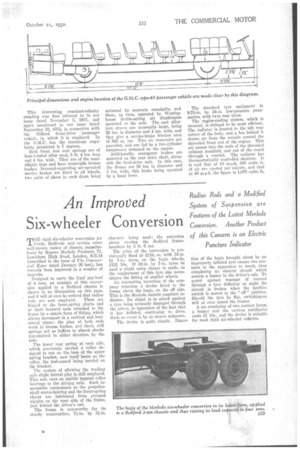An Improved Six-wheeler Conversion
Page 55

If you've noticed an error in this article please click here to report it so we can fix it.
THE rigid six-wheeler conversion for Fords, Bedfords and certain other well-known makes of chassis, natutufactured by Masons Morlode Products, 71, Lewisham High Road, London, S.E.14 (described in the issue of The Commercial Motor dated January 26 last),•has recently been improved in a number of respects.
Designed to carry the legal pay-load of 4 tons, an example of this conversion applied to a Bedford chassis is shown in an illustration on this page, and it will at once he noticed that radius rods are now employed. These are hinged to the front-spring chairs and at their forward ends attached to the frame by a simple form of fitting, which allows movement in a vertical and horizontal plane ; the pins at both ends work in bronze bushes, and short, stiff springs act as buffers to absorb shocks transmitted in either . direction by the rods.
The lower rear spring at each side, which previously carried a roller designed to run on the base of the upper spring bracket, now itself bears on the roller, the last-named being carried on the bracket.
71'he system of allowing the trailing axle slight lateral play is still employed. This axle runs on similar tapered roller bearings to the driving axle. Such inaccessible components as the propellershaft centre-bearing and the front-spring chairs are lubricated from grouped nipples on the near side of the frame, just behind the driver's cab.
The frame is noteworthy for its sturdy construction, 7fin. by 3i-in. channels being used ; the extension pieces overlap the Bedford framemembers by 3 ft. 6 ins.
The price of the conversion is provisionally fixed at £110, or, -with 34-in. by 7-in. tyres, on the bogie wheels, £122 10s. If 32-in. by '7-in. tyres be used a slight extra charge is made, as the employment of this tyre size necessitates the fitting of smaller wheels.
An interesting invention of the company concerns a device fitted to the frame above the bogie, on the off side. This is the Morlode electric puncture indicator. Its object is to guard against a tyre being seriously damaged through the driver, in ignorance of the fact that it has deflated, continuing to drive. Such an event is by no means unknown.
The device is quite simple. Distor tion of the bogie brought about by an improperly inflated tyre causes two contacts in the apparatus to Much, thus completing an electric circuit which sounds a buzzer in the driver's cab. To guard against wastage of current through a tyre deflating at night the circuit is broken when the ignition switch is moved to the " off " position. Should the tyre be flat, switching-on will at once sound the buzzer.
A set consisting of two contact boxes, a buzzer and the various auxiliaries costs 11 10s., and the device is suitable for most rigid six-wheeled vehicles.




































































































